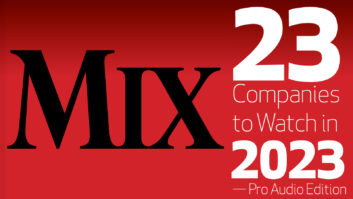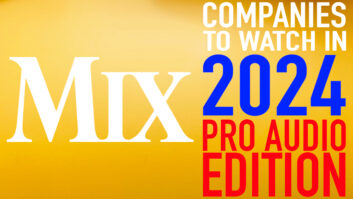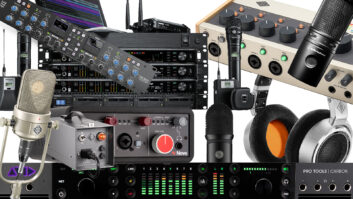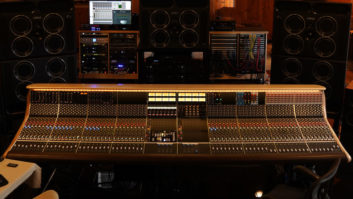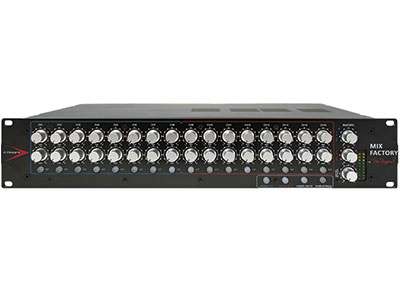
Mix Factory is a 16-channel analog summing system that allows a hybrid combination of a DAW’s editing precision, plug-in processing and automation with the sound of an analog console. It was initially conceptualized by music producer/engineer Tony Shepperd to facilitate his particular workflow and mixing style. Fix Audio’s Paul Wolff expanded on Shepperd’s idea with a custom-designed system that makes Mix Factory flexible enough to enable anyone’s workflow and mixing style.
Mix Factory comes in an all-steel 2U cabinet with top-notch internal construction that uses a combination of surface-mount technology and hand assembly. The 35 silver control knobs, stereo LED output meter and 20 pushbuttons are slightly recessed into a thick, black anodized aluminum front panel, making for an elegant presentation. It is powered by an included A Designs Audio 50- watt switch-mode external power supply connected using a sturdy 1.5-meter cable.
A single Mix Factory will accommodate up to 16 line-level signals coming into the unit via two rear panel 25-pin D-Sub connectors. Each channel input uses a THAT Corporation 1256 op amp chip that is diode-protected against accidental application of excessive voltage spikes—such as 48-volt phantom power.
For extra reliability and long life, each of the 16 channels use dual pots wired redundantly for both the pan pots (-3dB pan law with center detent) and the continuously variable Level controls (no detents). I liked the LED-lit Mute buttons that double as signal- present indicators, flashing green dynamically with audio peaks and turning red when muted.

A Designs Audio 50-watt switch-mode external power supply.
The 16 channels are split into two groups of eight, each feeding its own stereo bus with Sub Master level controls located on the front panel. Both of these stereo submaster buses have balanced rear panel send/return XLR connectors for inserting separate stereo processing, complete with lighted front panel Insert in/out buttons.
The two submasters mix into the Grand Master stereo bus in the Output Master section. Fitted with a pair of A Designs AD-10 discrete op amps, the Output section has its own set of send/return XLR connectors with a front panel Insert in/out button. A blue Bypass button is for the insertion of two gigantic Cinemag CM-ET3042 line output transformers. Switching of all audio signals—mutes, inserts and the transformer bypass—is done with sealed Axicom relays.
There are monitoring XLR outputs that are pre–master fader level, for separately monitoring volume level. The sound of the output transformers is included in the sound of the monitoring path if they are switched in. The rear panel finishes with an expansion XLR to add a second Mix Factory for a total of 32 channels. Up to 64 channels are possible by linking four units. Linking allows for the accumulative effect of the transformer’s sound in each Mix Factory if desired.
MIX FACTORY IN USE
Here is the way I set up the unit for a song I mixed that sounded so much better than the original inthe- box mix. Note: This is just one way and you are not limited in any way setting up Mix Factory depending on your specific workflow, track count and the requirements of your deliverables.
Using test tones coming out of Pro Tools (-18dBFS ref), I verified that all 16 channels were each contributing exactly the same level to the mix buses. For recall purposes, I set the stereo submasters and the Grand master controls at maximum—full up. I found that all level controls matched very closely in their actual knob positions. For faster mix recalls, adding a “calibrate” position for each of the 16 level pots would be a good update. A switch on each pot could substitute in a front panel accessible trim pot.
STEM CONFIGURATION
I always record mixes to a new stereo print track inside of Pro Tools, so I was able to quickly A/B between Mix Factory mixes and previous ITB mixes of the same song, all residing on the same playlist. I slipped all mixes together in time for instant X-OR soloing comparison.
I spread out all tracking instruments as individual mono or stereo stems into channels 1 through 8 under control of the first stereo sub master. The second eight channels (9 through 16) were configured this way: lead vocal (9); lead harmony (10); stereo background vocals (11 and 12); strings/ brass (13 and 14); and all mix effect returns (15 and 16).
For this song and for A/B’ing the ITB mix, I found it easier to dedicate two outputs from Pro Tools that contained all ambient and overall effect returns—reverbs, rooms, stereo wideners, delays used globally on all tracks. I like building mixes this way. I’m using Pro Tools automation exactly the same way as always, and I found that analog console “forgiveness”— you can make exaggerated mix moves, if required—without overloading Mix Factory’s buses and without having to back everything down and rebalance other mix elements.
I did get into the habit of using separate Master faders in the box for each stem output for occasionally automating stems. I also tried inserting my pair of Warm Audio WA-2A Leveling Amps on the tracking stereo submaster insert, and they worked great for that!
The sound of my mixes when using Mix Factory is noticeably bigger and clearer. They are stereophonically wider, and there is a depth of field I don’t get with the same mix done ITB. Mixing music this way has the sonic integrity of a good-sounding and well-maintained large-format analog console. There is a punchy presence; a clear, tight and thick sound that’s not muffled, dark or distant. Inserting the transformers adds low-frequency roundness and a kind of harmonic “glue.” For certain songs I liked the option of using the transformer as a final touch without having to deal with a significant level shift.
MIX FACTORY GOODNESS
I’m impressed with Tony Shepperd’s Mix Factory; it is like mixing on an analog console but using your favorite DAW automation, analog processing power and consistency. I’m can still personalize my mixes with my own particular input/output gain structuring in Mix Factory and freely use outboard analog processors as I would use when mixing on a desk.
PRODUCT SUMMARY
COMPANY: A Designs
WEBSITE: www.adesignsaudio.com
PRODUCT: Tony Shepperd’s Mix Factory
PRICE: $2,990 MSRP
PROS: Big-sounding 16-channel analog mixing console in 2U of rackspace.
CONS: Could use a calibrated switch for preset channel levels.
TRY THIS
The Mix Factory has sufficient headroom/dynamic range (+27dBu max input level) that I tried setting all 16 level controls to unity at fully clockwise. I liked this method for easy recall, and this “hot” setup drives the buses and any inserted processors harder. If you’re into transformer core saturation, you’ll get even more with this setup.
Barry Rudolph is an L.A.-based engineer and educator. Visit him at www.barryrudolph.com.


